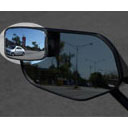
Blind spots are common in almost every make of passenger car and are certainly a problem for large vehicles like busses and trucks, even though they all have side mirrors. Trucks sometimes have a bumper sticker saying “If you can’t see my side mirrors, I can’t see you!” If you are not able to view their side mirrors you are not visible to the truck driver. Because of the danger of backing trucks in busy traffic there are precautions taken to ensure safety. For passenger vehicles however there are no provisions for the blind spots and bad visibility can often cause accidents which could have been avoided.
The MaxiView blind spot mirror can be fitted to any make and model of vehicle and it can even be used on large commercial trucks and utilities. By careful placement and adjustment the mirrors open up all the areas that were not visible from your driver’s seat, without turning your head around. You can even back in and out of driveways safely with the blind spot mirror. For instance if a child leaves a bicycle in the driveway and you get in the car to back out, you will easily see the bicycle in the blind spot mirror because you get a full span of vision with one fitted to each side mirror.
When there are several cars travelling on freeways and highways changing lanes frequently, you only need two cars to both have a blind spot moment at the same time, for a serious collision to occur. One of the reasons why some countries use their horns to indicate that they are changing fault lanes because they presume there are drivers that are not fully aware of them. The heavy and flowing traffic that is typical on all American main roads in peak hour is a disaster waiting to happen if the drivers are not able to see cars changing lanes right behind them. This is a common problem with many makes of car and often the back pillar is largely responsible for the blind spot. Installing a MaxiView blind spot mirror will remedy this situation, widening the visibility and preventing the likeliness of an accident.
